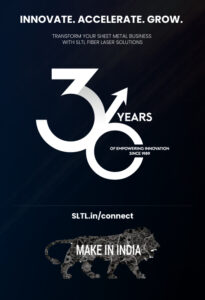India’s GDP grew 7.8% in Q1 FY 2025-26, driven by strong demand, manufacturing revival, and services growth. With SLTL’s laser tech powering industries from EVs to aerospace, India is set for sustainable, self-reliant expansion.
India has once again demonstrated its resilience and growth potential on the global stage. In the first quarter of FY 2025-26 (April-June 2025), India’s GDP grew at a remarkable 7.8% year-on-year, making it one of the fastest-growing major economies in the world. This growth came above market expectations and underscored the country’s strong domestic demand, capital investment momentum, and policy support.
For the full fiscal year 2025-26, GDP growth is projected in the 6.3-6.8% range, with the Reserve Bank of India (RBI) settling its forecast at around 6.5%. Despite global uncertainties, such as the impact of U.S. tariff hikes on exports, India’s economy remains well-anchored by strong fundamentals.
But what is truly driving this economic performance? Let’s explore how the manufacturing sector, alongside services and agriculture, has contributed to India’s GDP growth – and why this matters for companies like SLTL Group, a global leader in laser machine manufacturing.
Manufacturing: The Backbone of India’s Industrial Growth
The manufacturing sector has historically been viewed as the backbone of any growing economy. For India, this is especially true in 2025, as the country pushes for greater self-reliance under the “Make in India” vision and Production-Linked Incentive (PLI) schemes.
In FY 2024-25, manufacturing growth slowed to around 4.5%, compared to a robust 12.3% in the previous year. This dip was partly due to weak global demand and inflationary pressures.
However, in Q1 FY 2025-26, manufacturing saw renewed momentum, supported by rising domestic demand, capacity utilization (~75%), and government-led capex projects.
Manufacturing now contributes roughly 16-17% of India’s GDP, and policymakers are targeting a long-term goal of 25% by 2047.
Key drivers within manufacturing include:
- Automotive and EV components: With electric mobility gaining pace, precision laser cutting and welding machines are in high demand for battery packs, cushion cells, and lightweight components.
- Electronics and semiconductors: The PLI scheme has accelerated local manufacturing of smartphones, telecom equipment, and chips.
- Medical devices and healthcare equipment: Post-pandemic demand has spurred local production capacity.
SLTL’s advanced laser cutting machines, laser marking machine, and laser welding machines drive precision and efficiency across industries. In automotive and EVs, they provide solutions to handle battery packs and lightweight components; in electronics and semiconductors, for intricate chips and devices; in aerospace, and heavy engineering, they provide solutions for complex fabrication; in medical devices, they make stents, balloon catheters, and surgical instruments. Beyond these, SLTL machines serve jewellery industry, aerospace industry, construction industry and many more, enabling high-quality, automated production across India’s growing industrial sectors.
This industrial revival directly contributes to GDP not only by expanding output but also by creating jobs, attracting foreign direct investment (FDI), and reducing import dependency. For SLTL, this means an expanding customer base across sectors seeking cutting-edge laser solutions for precision, efficiency, and scalability. With exports to more than 48 countries worldwide, SLTL is not only powering Indian manufacturing but also strengthening global supply chains with its advanced laser technologies.
Anti-Dumping Policy: SLTL Driving Domestic Growth and GDP Impact
SLTL played a pivotal role in strengthening India’s industrial laser sector by initiating the complaint that led to the government imposing anti-dumping duties on imports of industrial laser machines from China. The Directorate General of Trade Remedies (DGTR) launched an investigation in September 2022 after SLTL highlighted that Chinese imports were being sold at unfairly low prices, causing significant material injury to the domestic industry.
As a result, definitive anti-dumping duties ranging from 24.66% to 147.20% were imposed on various Chinese manufacturers, effective from December 22, 2023. This move created a level playing field for Indian manufacturers and reduced the influx of cheaper imports.
SLTL’s leadership in this initiative has had a direct impact on India’s GDP. By protecting domestic production, it enabled local companies to expand manufacturing capacity, invest in R&D, and generate higher employment. This not only boosted output in the precision laser and manufacturing sector but also supported upstream and downstream industries such as automotive, electronics, and medical devices. Consequently, SLTL’s efforts have contributed to higher domestic industrial production, increased exports, and a stronger share of manufacturing in GDP – reinforcing India’s economic growth and self-reliance goals under the ‘Make in India’ vision.
Services: The Growth Engine of India’s GDP
While manufacturing is critical, it is the services sector that continues to be the largest contributor to India’s GDP.
- In FY 2025, services accounted for over 50% of GDP, led by IT, financial services, trade, logistics, and real estate.
- The IT-BPM industry alone is expected to cross $250 billion in revenues, driven by global demand for digital transformation, cloud solutions, and AI integration.
- Tourism, hospitality, and aviation showed strong rebound in 2024-25, contributing to employment and forex earnings.
The services sector’s strength has been twofold:
- It cushions the economy during downturns in manufacturing and agriculture.
- It enables manufacturing growth by providing logistics, R&D, financial support, and digital technologies.
For example, the integration of IoT, AI, and data analytics in laser cutting and welding systems areas where SLTL has pioneered smart manufacturing solutions is made possible through India’s growing services and digital ecosystem.
Agriculture and Allied Sectors: A Stabilizing Role
Agriculture may not dominate GDP share like services or manufacturing, but it remains vital for stability:
- Agriculture contributes about 15-18% of GDP and employs nearly 40% of India’s workforce.
- In FY 2025, the sector grew modestly at 3-3.5%, supported by better monsoon rainfall and government support schemes.
- Allied activities such as dairy, fisheries, and food processing showed steady growth.
Agriculture’s significance lies in its multiplier effect: a healthy rural economy translates into stronger demand for manufactured goods such as farm machinery, consumer durables, and infrastructure – all of which stimulate industrial output.
Note: Learn how SLTL is contributing in the agriculture and food processing sector with their laser solutions.
Other Key Contributors to GDP Growth
Construction & Infrastructure
- The construction sector grew by ~9% in Q1 FY 2025-26, driven by government spending on roads, railways, housing, and renewable energy projects.
- With infrastructure forming the bedrock of industrial expansion, this sector’s growth has a cascading effect on steel, cement, and machinery demand.
Mining & Energy
- Mining and quarrying grew at around 5%, supported by higher mineral production and energy needs.
- India’s renewable energy push (solar, wind, green hydrogen) also feeds into GDP growth while attracting international investment.
How the Sectors Work Together
India’s GDP growth story in 2025 is not the result of a single sector’s performance, but rather the synergy among manufacturing, services, and agriculture.
- Manufacturing provides industrial output and jobs.
- Services provide the infrastructure, finance, logistics, and technology backbone.
- Agriculture provides stability and demand from rural markets.
Together, these sectors form a balanced growth model, which has enabled India to outperform global peers despite external shocks like tariffs or slower world trade.
Implications for SLTL and the Manufacturing Ecosystem
For SLTL Group, India’s GDP momentum and sectoral growth trends open up significant opportunities:
- Rising Domestic Demand: As manufacturing rebounds, companies need advanced solutions for cutting, welding, marking, and automation. SLTL’s laser systems are designed to meet this demand with precision and speed.
- Integration with Smart Manufacturing: Services-led digitalization (IoT, AI, Industry 4.0) complements SLTL’s vision of intelligent, automated machines that improve efficiency and reduce waste.
- Export Competitiveness: India’s policy emphasis on exports in electronics, and engineering goods increases the demand for globally competitive fabrication technologies – an area where SLTL’s high-precision systems give manufacturers a cutting edge.
- Sustainability and Green Growth: With renewable energy, EVs, and green manufacturing taking center stage, SLTL’s clean laser technology provides eco-friendly alternatives to traditional cutting and welding.
Conclusion: India’s Growth, SLTL’s Opportunity
India’s GDP growth in 2025 highlights a resilient, multi-sector economy. Manufacturing, though temporarily slowed in the previous year, is on a revival path and will play an increasingly important role in shaping the future. Services continue to be the growth engine, while agriculture and allied sectors ensure stability.
For SLTL, this growth is more than just numbers – it is a call to innovate and deliver solutions that power India’s industries. From automotive and aerospace to medical devices and electronics, SLTL’s advanced laser machines will be at the heart of this transformation, ensuring that India not only grows faster but also manufactures smarter.
As India targets a $5 trillion economy and beyond, companies like SLTL will play a vital role in building the technology infrastructure that makes this growth sustainable, competitive, and future-ready.







